ALL THAT GLITTERS: ILLEGAL GOLD MINING IN GHANA–Chapter Three
1. Getting set
2. Expeditions to the hinterland ________________________________________________________________
1. Getting set
Kumasi was the base from which I launched all my expeditions to the gold mining areas. I had hired a driver, whom we’ll call Joe, for my entire trip. It’s customary for visitors to Ghana to rent a car along with a driver.
Kumasi is Ghana’s second largest city. We arrived around noon on a Saturday, and the first order of business was to settle into a marvelous hotel/B&B called Four Villages Inn, owned by Canadian-Ghanaian couple Chris and Charity Scott.
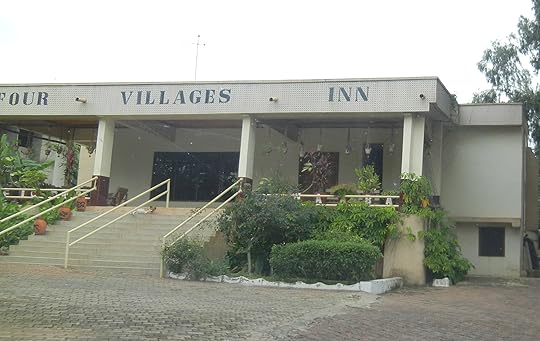
FOUR VILLAGES INN
(Photo Kwei Quartey)
Each of the four rooms has a theme. At FVI, you’re really staying in someone’s home, and not in a soulless hotel.
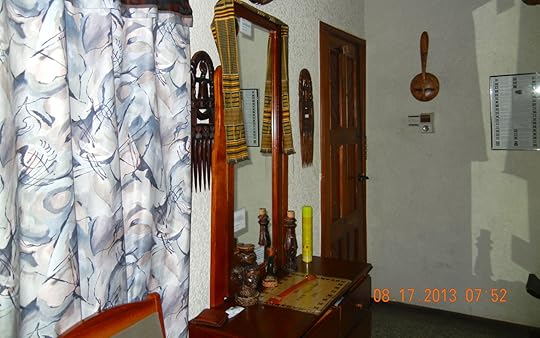
FVI “CARVER’S ROOM,” WHERE I STAYED
The day I arrived, I got in touch with a contact given to me while in Accra–a mechanic we’ll call Kojo, who works for the Obuasi Gold mine. We agreed we would meet the following day to discuss my needs in full. It’s about a 90 to 120-minute drive from Kumasi to Obuasi on a very good road. The state of the road to your destination is a primary factor in travel time management in Ghana.

KUMASI-OBUASI ROAD
(Photo Kwei Quartey)
Oh, one other thing–watch out for the checkpoint cops, who are very free with their radar guns and are happy to pull you over for speeding or anything else.
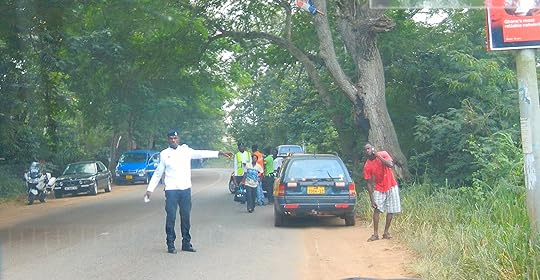
DRIVER’S LICENSE AND INSURANCE, PLEASE
(Photo Kwei Quartey)
The officer will aggressively tell you that he’s taking you to traffic court, you’ll beg, plead, argue, and ultimately offer him “a little something” to let you continue on your way.
Obuasi has a population of about 175,000. Its sister city in the US is Riverside, California. Like other towns of its size, Obuasi is rather quiet, although traffic can be surprisingly heavy at times.
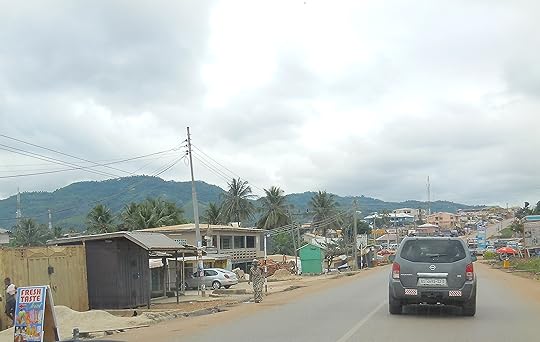
OBUASI HIGH STREET
(Photo Kwei Quartey)
Obuasi Mine, where Kojo works, is run by AngloGold Ashanti. It is one of the ten largest mines in the world, and is not to be confused with illegal gold mining in the area.

ANGLOGOLD ASHANTI–THIS IS LEGIT
(Photo Kwei Quartey)
I met Kojo Sunday around 11 a.m. at an outdoor restaurant , where we sat down for a drink and a chat. He was much younger than I had imagined from his voice on the phone, and very charismatic. I reiterated what I needed: to see everything possible related to illegal gold mining–safely. Not a problem. Kojo was happy to help. Born and bred in Obuasi, he knew where all the mines were. Even more importantly, he knew a lot of people particularly in the mining industry, in which he works himself. We settled on his per diem rate, and the next question was when to start. Kojo was willing to get going immediately, but after some discussion, he agreed with me that we ought to wait until I had talked to a senior officer at the Obuasi divisional headquarters of the Ghana Police Service. I wanted everything to be above board and find out if from a law enforcement perspective there was anything I needed to be aware of.
That meeting took place on Monday morning. The senior officer I spoke with was affable and knowledgeable. I had been referred to him by a detective friend of mine at CID Headquarters in Accra, and it helped that the senior officer knew my friend well. In Ghana, personal relationships and friendships are more important than formal policy and procedure. The meeting was successful and he shared some fascinating insights with me. The bottom line was, I was cleared for takeoff.
2. Expeditions into the hinterland
The following day, and over the next two weeks, Joe, Kojo and I set off to villages far off the beaten path. No more nice highways–this was brain-rattling, intestine-jiggling travel for which a 4×4 vehicle is essential. An ordinary sedan could be shaken to bits by some of these roads, and get stuck in deep mud during the rainy season.

A ROUGH ROAD DEEP INTO THE BUSH
(Photo Kwei Quartey)
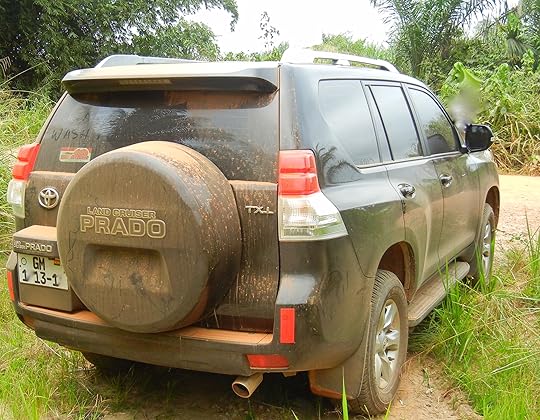
PUTTING THE LAND CRUISER PRADO THROUGH ITS PACES
(Photo Kwei Quartey)
Later on along the route, we came across a young man hanging off the back of a moving Land Rover being used as a commercial passenger vehicle–an example of one of the many things you see in Ghana that make you shake your head in disbelief. Check this out:
In the background you can someone on a religious radio station, which are legion in Ghana.
At a village called Amemriwa (“Ah-memry-wah”), we sat down with two men and a woman who lived there and whom Kojo knew from a prior visit.

WE SAT IN THE SHADE OF A TREE FOR OUR DISCUSSION
(Photo Kwei Quartey)
In more traditional societies in Ghana, there’s often an interval in which not much is said before the discussion gets underway. You will always be brought a seat, and there may be a ceremonial and unhurried shaking of hands. Just go with the flow. Your hosts will finally ask how they can help, or “what is your mission?”

A CURIOUS TEENAGER OBSERVES US
(Photo Kwei Quartey)
Kojo explained why we were there and what my particular interest was. He was very skillful at “adapting” the reason for my visit according to the audience. For some, he said I was writing a “storybook” about mining that would have illustrations, and therefore I needed to see the mining areas and take photos; with others he said that I was personally interested in starting up my own mining company.
But never would he say I was from the media–that would have set off alarm bells and make people clam up immediately and/or express hostility. What many Ghanaians, even in “remote” areas such as this, think of foreign media in particular is that they come, they see, they form their own ideas about what is going on, and then they return to their home countries to write slanderous untruths. So suspicion abounds, but Kojo is one of the most charming and reassuring speakers I know and the way he put everyone at ease was impressive. Very few of the excursions we made could have been done without his help.
The men from the village got in the Prado with us and we drove off toward the mines. We got to a spot that was impassable, so we parked and went the rest of the way on foot. Roads like this barreling through cleared forest were created almost invariably by the Chinese to provide access to mining areas.

KOJO (CENTER) WITH TWO MEN FROM THE VILLAGE
(Photo Kwei Quartey)
After about half a mile, we came across a Chinese man and three Ghanaians unloading some mining equipment from the back of a pickup. Definitely some activity going on here. 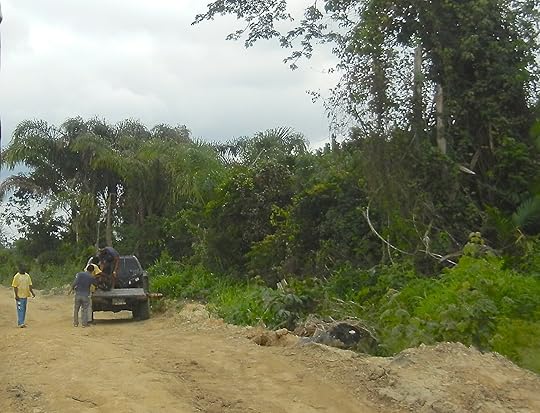 A few minutes later, we spotted the mining camp up ahead from which the men we had just seen must have been coming.
A few minutes later, we spotted the mining camp up ahead from which the men we had just seen must have been coming.

CORRUGATED METAL GATE TO THE CAMP
(Photo Kwei Quartey)
I was a little hesitant about approaching, but because our two guides from the village knew one or two of the Ghanaian workers in the camp, no issue arose. They chatted in Twi (the dominant indigenous language in Ghana), and I gather Kojo referred to my personal interest in mining as the rationale for my being there. There was one Chinese man there who was curious, and perhaps a little nervous, about our visit, but after figuring out that this was a non-threatening situation, he shook hands cordially with us. He said nothing and didn’t appear to speak any English. From the newness of the gate and the organized appearance of the compound, it was clear that this group was just getting started, and it turns out there was good reason for the Chinese man’s nervousness. Months before, there had been a violent conflict in this area between some Chinese miners and Ghanaians. Some time after that, the crackdown by the Ghana government had begun. It was impossible to tell if the Chinese men we were now encountering were ex-deportees or just among those who had hidden out or lain low during the purge. Obviously, I didn’t ask.
From the camp, we made our way to an illegal mine.

OVER THIS HILL IS AN ILLEGAL MINE
(Photo Kwei Quartey)
I was about to see an amazing sight.
Next chapter: Environmental destruction



